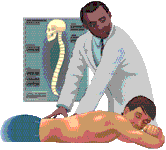

Excerpted from the 8/99 - 11/99 Newsletter
TABLE OF CONTENTS
- Ear Problems from Changes in Pressure Helped Through Chiropractic
- Silent Subluxators
- Chiropractic and Optimal Performance
Ear Problems from Changes in Pressure Helped Through Chiropractic Table of Contents | Go Top
The following is a synopsis of: Doyle, E.P., Dreifus, L.I., and Dreifus G.L. "Aerotititis Media: A Case Report." Chiropractic Sports Medicine, 1995; Vol. 9, No. 3: pp. 89—93. Publisher: Williams and Wilkins; Baltimore, MD.
Barotitis or aerotitis media is an acute inflammation of the middle ear caused by air pressure changes between the middle ear and the atmosphere. This pressure difference causes distortion of the ear drum, which may lead to bruising, bleeding, pain, dizziness (vertigo), hearing loss and ringing in the ears (tinnitus). Aerotitis media is common among scuba divers and air travelers, two groups that deal constantly with pressure changes. Some factors which leave the diver or air traveler more vulnerable to this condition are upper respiratory problems (head colds, sinus infections, etc.), chronic middle ear problems, ruptured ear drums, deviated septums and previous middle ear surgeries.
The patient in this report was a 35 year old male with a history of eustachian tube blockage since childhood. Antihistamines offered no relief from these previous episodes. When he first arrived at the chiropractic office, he was suffering from a feeling of fullness in the ears, hearing loss and ringing in the ears, which began during a recent scuba diving trip. Audiometry (standard battery of hearing tests) revealed a mild conductive hearing loss in the left ear. Examination with a tympanometer (a device that detects congestive middle ear pathology), demonstrated abnormal signs in both ears. Taken together, these findings confirmed the presence of aerotitis media.
Chiropractic examination revealed vertebral subluxations involving both the upper and the lower neck with no medical pathology visible on x-ray. The patient was seen twice per week for five weeks. At the end of this period, audiometry and tympanometry were both within normal limits, and the patient’s symptoms had subsided.
 Current medical treatment for aerotitis media consists of a combination of antibiotics,
decongestants, inflation of the eustachian tubes and surgery (myringotomy). Obviously,
scuba diving and air travel have to be restricted during care.
Current medical treatment for aerotitis media consists of a combination of antibiotics,
decongestants, inflation of the eustachian tubes and surgery (myringotomy). Obviously,
scuba diving and air travel have to be restricted during care.
The patient in this case improved rapidly under chiropractic care without risking the deleterious effects of drugs or surgery. This implies that vertebral subluxation – especially in the neck – may interfere with recovery from aerotitis media. If so, chiropractic adjustments would assist the body in returning middle ear function to normal. The authors of this study call for additional research in this area.
Silent Subluxators Table of Contents | Go Top
Rapid change is difficult for us to ignore, but sameness sinks below our attention. Trauma is a type of rapid change, therefore, traumatic sources of subluxations ("pinched nerves") are easy to identify. Accidents, falls, sports injuries, etc., are included in this category.
However, such obvious trauma only accounts for a fraction of subluxations. Ever present sources of stress are hidden by the invisibility of the familiar and the obscurity of the obvious. These sources of stress can become "silent subluxators." Detecting them is often a matter of heeding hunches and perceiving patterns.
Do you find that you do not feel too well a few days after laundry day? Perhaps your clothes drier is not doing such a good job. Slightly damp clothing, hot from the drier, may feel misleadingly dry at first. Your slightly damp garment may acquire just enough mildew to trigger allergic reactions, but not enough to cause obvious odors or discoloration. Allergic reactions can change your internal chemistry, alter your breathing patterns, irritate your eyes, etc., all of which can make you more subluxation-prone.
Adverse reactions to vaccinations can have profound effects on the nerves, joints and muscles. This can be another under-appreciated source of subluxation. These reactions are often not recognized because they may follow the injection by days, weeks or even months. While such reactions are a major concern for infants and children, persistent post-vaccination problems have been described in adults as well.1
Cervical (neck area) subluxations can be related to dental problems. A research team in England found a statistical correlation between impacted wisdom teeth and subluxations in a population of chiropractic patients.2 These same patients often suffered from headaches.
Have you recently changed your prescription for glasses or contact lenses? Visual stress, like dental problems can generate or aggravate cervical subluxation.
Do you seem to have lower or upper back problems after sitting on a lawn mower, tractor or other piece of outdoor equipment? Low-frequency vibration generated by machinery has been shown to be a risk factor for problems associated with subluxations, especially in the thoracic and lumbar (upper back and low back) areas.3,4
In the early years of chiropractic, the profession’s founder, D.D. Palmer, stated that subluxations could be caused by "traumatism, poison or autosuggestion." In modern parlance, we would say that subluxation can be related to mechanical, chemical or emotional stressors. As noted in the above examples, detecting the more subtle of these stressors is difficult, but possible. The more of these"silent subluxators" you identify and either avoid or neutralize, the healthier you will be.
1 Mitchell, L.A., A.J. Tingle, R. Shukin, J.A. Sangeorzan, J. McCune, and D.K. Braun. "Chronic Rubella Vaccine-Associated Arthropathy." Archives of Internal Medicine, 1993; Vol. 153; pp. 2268—2274.
2 Dawson, L., and S. Frolund, "The Relationship Between Impacted Wisdom Teeth, Headaches and Persistent Cervical Fixations." European Journal for Chiropractic, 1992: Vol. 40: PP. 1—6.
3 Riihimakl, H., S. Tola, T. Videmn, and K. Hanninen, "Low-Back Pain and Occupation: A Cross-Sectional Questionnaire Study of Men in Machine Operating, Dynamic Physical Work, and Sedentary Work." Spine, 1989; Vol. 14: pp. 209—209.
4 Johanning, E., "Back Disorders and Health Problems Among Subway Train Operators Exposed to Whole-Body Vibration." Scandanavian Journal of Work and Environmental Health, 1991; Vol 17: pp. 414—419.
Chiropractic and Optimal Performance Table of Contents | Go Top
Chiropractic care is often thought of as a therapy for back pain and other joint and muscle pains. Actually, chiropractic adjustments are designed to alleviate nerve irritation, which liberates the innate healing abilities of the body, and allows a fuller expression of personal potential. Pain control is just one small aspect of this.
Recently, chiropractic researchers in Vienna, Virginia reported that patients often mention an improved ability to take a deep breath after a chiropractic adjustment.1 In some cases, this subjective improvement in the ease of breathing is accompanied by a measurable increase in lung volumes. An interesting aspect of this research is that patients often do not notice that there is any problem with their breathing until a chiropractic adjustment improves it.
 A research team at National Chiropractic College near Chicago, Illinois reported an
increase in the activity of certain cells vital to the immune response after chiropractic
adjustments.2 The volunteers receiving these
adjustments were not suffering from any symptoms at the time of the study, but
chiropractic examination revealed areas of dysfunction in their spines. Correction of
these dysfunctions caused an apparent improvement in the capacity of their immune systems.
A research team at National Chiropractic College near Chicago, Illinois reported an
increase in the activity of certain cells vital to the immune response after chiropractic
adjustments.2 The volunteers receiving these
adjustments were not suffering from any symptoms at the time of the study, but
chiropractic examination revealed areas of dysfunction in their spines. Correction of
these dysfunctions caused an apparent improvement in the capacity of their immune systems.
At Life Chiropractic College near Atlanta, Georgia, research with computerized mapping of brainwave activity has demonstrated that improved brain function is often a "side effect" of the chiropractic adjustment.3 These findings take on additional significance in light of research published by a Philadelphia chiropractor, who demonstrated a correlation between certain spinal distortions noted on x-ray and certain personality disorders detected by psychological testing.4
An experiment conducted by researchers affiliated with Palmer Chiropractic College in Davenport,Iowa compared two groups of athletes.5 One group received chiropractic adjustments over a six week period, while the other group was simply observed. A battery of tests was administered before and after this six week period. The tests measured such things as balance, agility and power. The athletes under chiropractic care demonstrated significantly more improvement than the "control group" of athletes. Particularly dramatic was the improvement in reaction time, with the "chiropractic" athletes demonstrating better than 18% improvement, while the "controls" improved less than 1%.
On the athletic field, the workplace, the classroom, and in all other aspects of health and life, the goal of chiropractic care is optimal human performance. Recent research findings support the idea that chiropractic care can indeed contribute towards this goal.
1 Masarsky, C.S., and M. Weber, "Somatic Dyspnea and the Orthopedics of Respiration." Chiropractic Technique, 1991; Vol. 3: pp. 26—29.
2 Brennan, P.C., K. Kokjohn, C.J. Katlinger, G.E. Lohr, C. Glendening, M.A. Hondras, M. McGregor, and J.J. Triano, "Enhanced Phagocytic Cell Respiratory Burst Induced by Spinal Manipulation: Potential Role of Substance P." Journal of Manipulative and Physiological Therapeutics, 199 Vol. 14: pp. 399—408.
3 Hospers, L.A., "EEG and CEEG Studies Before and After Upper Cervical or SOT Category II Adjustment in Children After Head Trauma, in Epilepsy and in Hyperactivity." Proceedings of the National Conference on Chiropractic and Pediactrics (ICA), 1992; pp. 84—139.
4 Koren, T., and E. Rosenwinkel, "Spinal Patterns as Predictors of Personality Profiles: A Pilot Study." International Journal of Psychosomatics, 1992; Vol. 39: pp. 10—17.
5 Lauro, A., and B. Mouch, "Chiropractic Effects on Athletic Ability." Chiropractic: The Journal of Chiropractic Research and Clinical Investigation, 1991; Vol. 6: pp. 84—87.
This Newsletter is Copyright © Drs. Marion
Todres and Charles Masarsky, Chiropractors. All Rights Reserved.